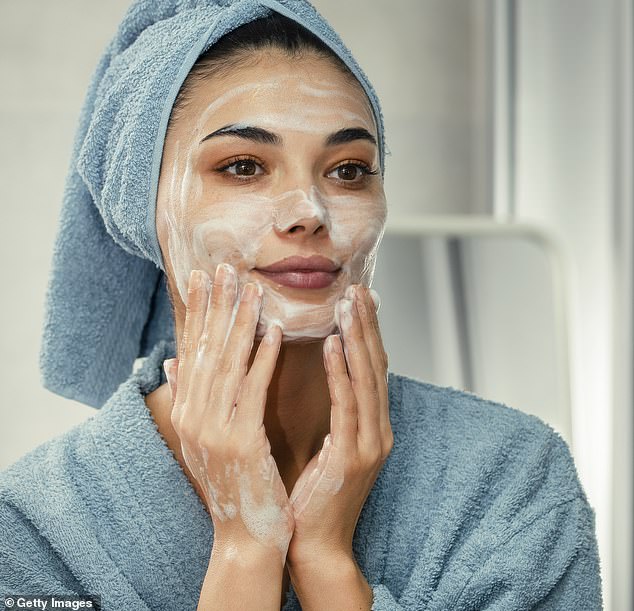Six signs your anti-ageing routine is damaging your face, revealed by an expert
Given the dizzying number of anti-aging skin care products out there, it’s clear that many of us are eager to discover the secret formula for youthful, even-toned skin.
But dermatologists and cosmetic doctors warn that this pursuit of perfection can turn into an obsession. Experts are seeing an alarming increase in middle-aged women suffering from a new condition, “dermorexia.”
This is an obsessive preoccupation with using excessive amounts of skin care treatments and following an elaborate beauty routine. Ironically, applying too many products, many of which contain harsh active ingredients, can cause or worsen skin conditions such as acne, eczema, dermatitis, rosacea and psoriasis.
‘I’ve seen people spend upwards of £2,000 a month on skincare,’ says Dr Penelope Tympanidis, a dermatologist who consults Harley Street. ‘On products they don’t need.’
Penelope Tympanidis, dermatologist at Harley Street, says she’s seen people spend more than £2,000 a month on skincare
Dermorexia first hit the scene among teens and young adults when beauty influencers known as “Sephora Kids” began sharing their 12-step skincare routines on TikTok. Now, it’s spreading like wildfire among middle-aged women seeking poreless, glowing skin to mimic the filters they use on social media.
Dermorexia manifests itself in a variety of ways, with the above skin conditions being common. But Dr. Tympanidis says typical cases can range from dull, congested skin prone to blackheads and acne to super-sensitive, red, and often flaky skin.
The first is caused by overuse of nourishing anti-aging creams and rich moisturizers, and the second by overuse of products with high concentrations of glycolic acid, niacinamide, retinol, salicylic acid and AHAs (alpha hydroxy acids). These can cause inflammation and damage the skin.
A good example is Tiffany, a 45-year-old lawyer from London, who was unknowingly suffering from ermorexia when she visited Dr. Surbhi Virmani, a cosmetic dermatologist.
Dermorexic users often suffer from psychological problems, which are exacerbated by low self-esteem. This causes them to consume far more products than they need.
A good example is Tiffany, a 45-year-old lawyer from London, who unknowingly suffered from Dermorexia when she visited Dr. Surbhi Virmani, a cosmetic dermatologist.

Experts are witnessing an alarming rise in middle-aged women suffering from a new condition, ‘dermorexia’
‘Tiffany ruined her complexion with harsh acids and too many exfoliants, leaving her skin feeling rough and sensitive. The condition also affected her self-confidence. The good news is that we’ve fixed it with the right skin care and a little patience.’
Dr Virmani recommends a simple three-step routine. ‘My favourite budget cleansers are Byoma (£9.99, Boots.com). They come in cream and gel formulas to suit individual needs and are fantastic at soothing sensitive skin. For hydration, try a new Polish brand called ProXN (proxn.eu./home-nl), contains a powerful yet mild antioxidant from hops, which helps strengthen and restore the skin barrier and prevent inflammation.
‘A good SPF is important all year round and Synchrorose Intensive SPF30 (£40, drmedispa.com) and Theraderm Platinum Protection (£30.99, theraderm.net) are wonderful sunscreens for sensitive skin. I also recommend not cleansing in the morning if the skin barrier is already compromised, as this can make the problem worse.’
Do you suffer from Dermorexia?
1. You suddenly suffer from sensitive or reactive skin
New problems such as pimples, redness and dermatitis are often attributed to overuse of products.
Overuse of occlusive products—designed to lock in moisture—can clog pores, causing inflammatory acne. If you like layering products, opt for noncomedogenic products that won’t disrupt skin function. Try brands like La Roche Posay, Cerave, Cetaphil, Neutrogena, Dermalogica, and Eucerin.
2. You see multiple skin experts, without satisfaction. This is a ‘red flag’, says Dr. Wassim Taktouk
‘The people I have seen who suffer from dermorexics invariably tell me that they are prescribed different products by the different doctors they see.’
3. You are obsessed with achieving ‘glass skin’
The hashtags ‘Glass skin’ or ‘dolphin skin’ on social media have been blamed for contributing to the rise in dermorexia. ‘These images are not realistic and usually show a person applying oil to their skin and using a good ring light,’ says facialist Teresa Tarmey.
4. Your eyes are swollen
“There are also small blood vessels around the eye socket that can dilate and temporarily swell with excessive use of rich eye creams,” says Dr. Tympanidis. “Gently dab a pea-sized amount of eye cream onto the periorbital bone (top of the cheekbone) and let it spread over the area rather than smearing it over the eyelids.”
5. You have cupboards full of unused products
Most mainstream skincare products with stabilized actives have an expiration date and lose their effectiveness after two years, while “organic” products only last six months. “People are wasting their money and compromising their skin condition,” says Dr. Emma Craythorne, who advocates three skincare steps in the morning (cleanser, moisturizer and sunscreen) and two in the evening (cleanser and night cream).
6. You forensically examine small changes in your face
“It’s gone from patients having unrealistic expectations about what can be achieved with skin care to patients being convinced that there is something physically wrong with their face,” said Dr. Taktouk.
‘A big part of my job now is to reassure patients that their skin looks completely normal and then help them simplify their routines.’
